Contents
- Three ordinances to boost farm income, attract investors
- CWMA, CWRC meeting on June 2020
- Vandalism of Buddhist rock engravings in Gilgit-Baltistan
- India-China Trade amid Pandemic
- Lt Gen-level talks between India, China on June 6
- India to boost infrastructure in areas along China border
THREE ORDINANCES TO BOOST FARM INCOME, ATTRACT INVESTORS
Focus: GS-III Indian Economy
Why in news?
Formalising its plan to unlock the growth potential of farm incomes by allowing unrestricted sale of produce, the Centre on 3rd June 2020, approved three major legislative reforms through ordinances intended to create “one India, one agriculture market” while attracting private investments in a sector crippled by varying regulations.
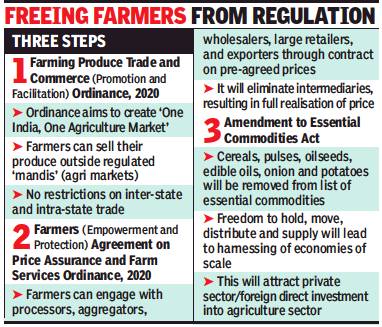
Ordinance on Contract Farming
- The three legislative reforms include laws on promoting barrier-free inter-state and intrastate trade in agriculture produce, empowering farmers to engage with processors, aggregators, wholesalers, large retailers and exporters through advance contracts on pre-agreed prices.
- The ordinance on contract farming — Farmers (Empowerment and Protection) Agreement on Price Assurance and Farm Services Ordinance, 2020 — looks to transfer the risk of market unpredictability to the sponsor and also enable the farmer to access modern technology and better inputs.
Ordinance to Amend ECA
- The reforms also include an amendment to the Essential Commodities Act which removes cereals, pulses, oilseeds, edible oils, onion and potatoes from list of essential commodities.
- The amendment in the ESA will give freedom to hold, move, distribute and supply such farm commodities and attract private sector and foreign direct investment into agriculture sector.
- The amendment to the ESA has provisions to regulate agricultural items in situations such as war, famine, extraordinary price rise and natural calamity.
Is this a case of Center legislating on a State Subject?
The Ordinances are said to be within the domain of the central government as it deals with inter-state trade of agriculture produce which was covered under the “Central” list.
Essential Commodities Act
- The ECA is an act which was established to ensure the delivery of certain commodities or products, the supply of which if obstructed owing to hoarding or black-marketing would affect the normal life of the people.
- The ECA was enacted in 1955. This includes foodstuff, drugs, fuel (petroleum products) etc.
- It has since been used by the Government to regulate the production, supply and distribution of a whole host of commodities it declares ‘essential’ in order to make them available to consumers at fair prices.
- Additionally, the government can also fix the maximum retail price (MRP) of any packaged product that it declares an “essential commodity”.
- The list of items under the Act includes drugs, fertilizers, pulses and edible oils, and petroleum and petroleum products.
How Essential Commodities Act works?
- If the Centre finds that a certain commodity is in short supply and its price is spiking, it can notify stock-holding limits on it for a specified period.
- The States act on this notification to specify limits and take steps to ensure that these are adhered to.
- Anybody trading or dealing in a commodity, be it wholesalers, retailers or even importers are prevented from stockpiling it beyond a certain quantity.
- A State can, however, choose not to impose any restrictions. But once it does, traders have to immediately sell into the market any stocks held beyond the mandated quantity.
What are Food Items covered under it?
- The items covered include rice, wheat, atta, gram dal, arhar dal, moong dal, urad dal, masoor, dal, tea, sugar, salt, Vanaspati, groundnut oil, mustard oil, milk, soya oil, palm oil, sunflower oil, gur, potato, onion and tomato.
- Based on the deliberations, Government takes various measures from time to time to stabilize prices of essential food items which, inter-alia, include appropriately utilizing trade and fiscal policy instruments like import duty.
- The govt. can impose stock limits and advise State for effective action against hoarders & black marketers etc. to regulate domestic availability and moderate prices.
-Source: Times of India
CWMA, CWRC MEETING ON JUNE 2020
Focus: GS-II Governance, Environment , Prelims
Why in news?
- The Cauvery Water Management Authority (CWMA), after being notified formally as a body under the Union Ministry of Jal Shakti in late April, will hold its first meeting through videoconferencing on June 10.
- The Cauvery Water Regulation Committee (CWRC) will have its meeting on June 9.
Comfortable Storage
- The two events will take place a few days before the opening (June 12) of the Mettur dam, regarded as the lifeline of the Cauvery delta in Tamil Nadu, for irrigation.
- It is because of the excess flow of the Cauvery water and relatively moderate rainfall during the northeast monsoon (October-December) in 2019 that the Mettur dam is now having a comfortable storage.
- After a gap of 12 years, the dam is getting opened on the customary date. It is after an interval of nine years; the opening is happening in June.
- This “Kudimaramathu” scheme is in progress as well.
Cauvery Water Management Authority (CWMA)
- CWMA has been created as per the Cauvery Management Scheme framed by Centre and approved by Supreme Court.
- The Cauvery Management Scheme deals with release of water from Karnataka to Tamil Nadu, Kerala and Puducherry.
- It will be implemented by Cauvery Management Authority (CMA).
- CMA will be sole body to implement CWDT award as modified by Supreme Court.
- The Central Government will have no say in implementing of the scheme except for issuing administrative advisories to it.
- The authority will comprise a chairman, a secretary and eight members.
- Out of the eight members, two will be full time, while two will be part time members from centre’s side. Rest four will be part time members from states.
- The main mandate of the CMA will be to secure implementation and compliance of the Supreme Court’s order in relation to “storage, apportionment, regulation and control of Cauvery waters”.
- CMA will also advise the states to take suitable measures to improve water use efficiency.
- It will do so by promoting use of micro-irrigation, change in cropping patterns, improved farm practices and development of command areas.
- The CMA will also prepare an annual report covering its activities during the preceding year.
Cauvery Water Regulation Committee (CWRC)
- The Central government constituted the Cauvery Water Regulation Committee (CWRC) as per the provisions in the Kaveri Management Scheme laid down by the Supreme Court.
- While the CWMA is an umbrella body, the CWRC will monitor water management on a day-to-day basis, including the water level and inflow and outflow of reservoirs in all the basin states.
Kudimaramathu
- Tamil Nadu State government has turned to traditional ‘Kudimaramathu’ or maintenance of waterbodies with participation of local farmers, aimed at “faster and more efficient” execution of works related to maintenance and repairs of irrigation tanks and channels.
- It is a scheme by Tamil Nadu government which aims to restore the water bodies of Tamil Nadu such as dams, lakes and reservoirs, with the help of local farmers.
- In Tamil, the word “Kudi” means people and “Maramathu” means repairing or construction. Kudimaramathu is a centuries-old system of collective repair of water bodies, which discontinued in the colonial era.
- Through this scheme the Tamil Nadu Government attempts to revive an ancient lake management system.
-Source: The Hindu
VANDALISM OF BUDDHIST ROCK ENGRAVINGS IN GILGIT-BALTISTAN
Focus: GS-I Art and Culture, Geography, Prelims
Why in news?
India has reacted strongly to reports of vandalism and defacement of ancient Buddhist rock carvings in Gilgit-Baltistan under Pakistan’s control.
Buddhist Carvings in Gilgit-Balistan
- Before arrival of Islam in the region of Gilgit-Baltistan the majority of the people were Buddhist and they had engraved the Buddha on many rock pieces.
- This Buddha carving was not known to the world till beginning of 20th century due to its remote location.
- Kargah Buddha is an archaeological site located about 9.7 km outside of Gilgit. It is a carved image of a large standing Buddha, some 50 feet high, in the cliff-face in Karghah Nala. The carving, which is in a style also found in Baltistan, probably dates to the 7th century.
- Manthal Buddha Rock is a large granite rock on which picture of Buddha has engraved which probably dates back to 8th century.
Gilgit-Baltistan
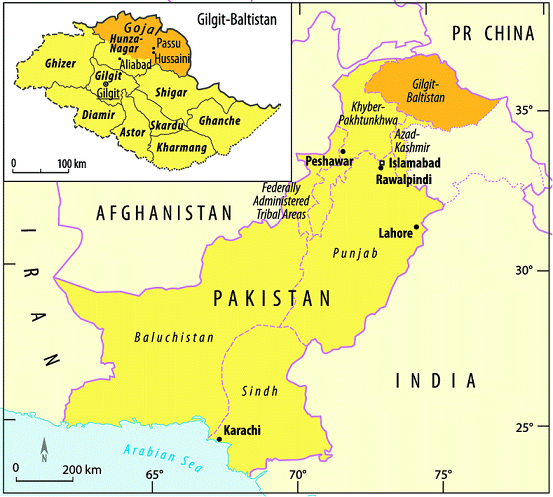
- Gilgit-Baltistan is a region administered by Pakistan as an administrative territory, and constituting the northern portion of the larger Kashmir region which has been the subject of a dispute between India and Pakistan since 1947, and between India and China from somewhat later.
- Gilgit-Baltistan is part of the greater Kashmir region, which is the subject of a long-running conflict between Pakistan and India.
- The territory shares a border with “Pakistan administered Kashmir” (Called Azad Kashmir by Pakistan) and union territories of Jammu and Kashmir (union territory) and Ladakh separated from it by the Line of Control.
- Pakistan is a federation that comprises four provinces: Punjab, Khyber Pakhtunkhwa, Sindh and Balochistan and three territories: Islamabad Capital Territory, Gilgit–Baltistan and Azad Kashmir (according to Pakistan).
-Source: Hindustan Times
INDIA-CHINA TRADE AMID PANDEMIC
Focus: GS-III Indian Economy
Why in news?
- In May 2020, India mandated government approval for foreign direct investment (FDI) from countries with which it shares land borders.
- The curbs aimed to shield Indian companies from predatory investments, particularly those from China—a big hint that policymakers in New Delhi have become ever more cautious of Beijing’s growing role in the Indian economy.
Restrictions on China
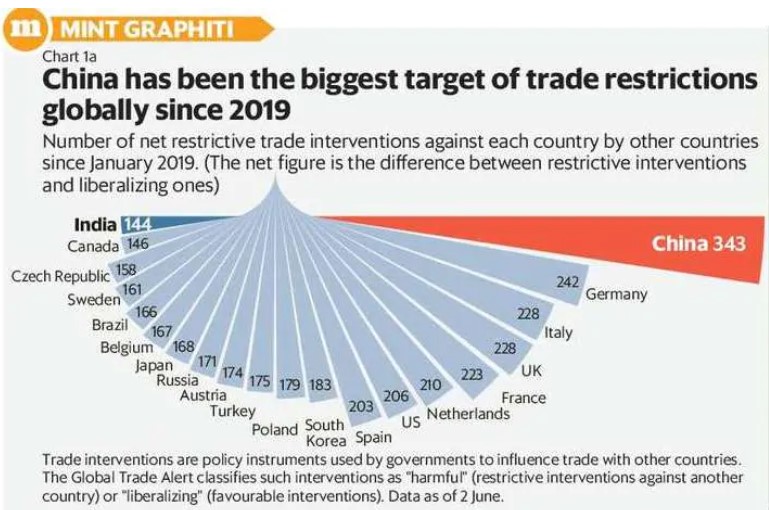
- Latest data from Global Trade Alert shows it has faced more trade restrictions than any other country since 2019.
- The fear of predatory investments in the wake of covid-19 disruptions has made India more alert, but analysts and diplomats have been sounding alarm over it for a very long time.
- India’s FDI measure against its neighbours came days after the Chinese central bank raised its stake in HDFC to over 1% in April.
- To be sure, China’s investments, even after including Hong Kong, contribute only a tiny share in India’s total FDI inflow.
- This holds true even if one goes by China’s numbers, which are higher.
- Given the small FDI share, some of the fears may even be exaggerated because of the growing mistrust towards Beijing, but not all of it.
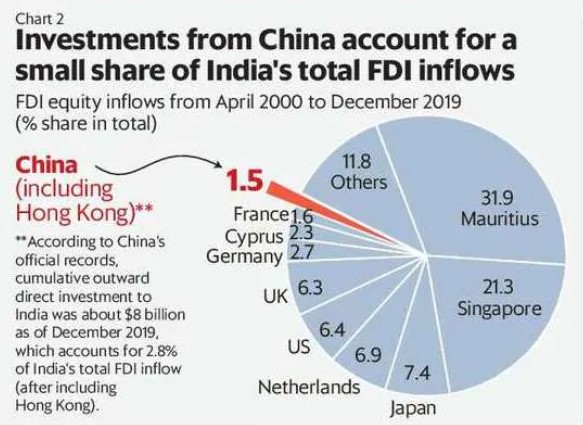
China’s Debt-trap Diplomacy
- Research shows developing countries owe much larger debts to China than was earlier believe.
- They allege many loans to build infrastructure projects using Chinese contractors in strategically located developing nations are a form of debt-trap diplomacy.
- China is accused of extending excessive credit with the intention of extracting economic or political concessions when countries cannot honour their debts. This raises fears that China’s credit to countries such as Pakistan, Sri Lanka and Nepal could be a strategic disadvantage for India.
India’s Dependence on Chinese Imports
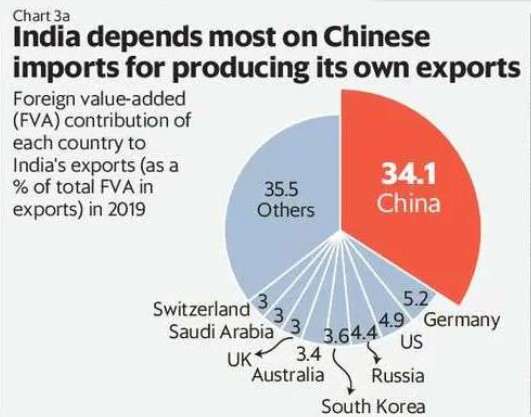
- India must remember that even though its widening trade deficit with China remains an eyesore for policymakers, dependence on Chinese products has only grown year after year.
- In 2019, Chinese imports alone accounted for 34% of all the foreign value-added in India’s exports, data from the United Nations Conference on Trade and Development shows. In 2009, this figure was just 1.8%.
- Over the last decade, India’s dependence on China for inputs for the manufacture of drugs and consumer goods has shown a marked increase. All this will matter even more in this time of crisis after the coronavirus.
- A strengthening anti-China sentiment and louder calls for self-reliance could actually go against India’s interests and economic logic.
India’s Handling and Way Forward
- Indeed, India has played it safe by only blocking the automatic route for investments and not tightening the limit itself. Nor has it named China explicitly.
- To recover from the demand shock, India needs low prices that Chinese goods provide.
- There is no single policy to tackle the complex and multifaceted relationship. Even as India confronts China militarily, the need of the hour is better economic cooperation.
-Source: Livemint
LT. GEN-LEVEL TALKS BETWEEN INDIA, CHINA ON JUNE 6
Focus: GS-II International Relations
Why in news?
A meeting on June 6 between Indian and Chinese military officials, led by lieutenant generals from both armies, will be a significant step towards resolving the weeks-long row along the Line of Actual Control (LAC).
Details
- This is perhaps the first time that lieutenant generals from both sides will meet in a sensitive sector to defuse border tensions – the highest talks between India and China at the tactical level have so far usually involved major generals.
- Several rounds of talks between local military commanders, including three rounds of discussions between major generals, have failed to break the impasse that began with a violent confrontation between rival patrols near Pangong lake four weeks ago.
China’s Aggression
- China has marshalled close to 5,000 soldiers and deployed tanks and artillery on its side of the disputed border in Ladakh sector, where India has also sent military reinforcements and matched the neighbour’s military moves.
- The external affairs ministry has said that Chinese troops have hindered patrols by Indian forces on the Indian side of the LAC and that contacts have been established through military and diplomatic channels to address the situation.
Click Here to read more about the India China Conflict
-Source: Hindustan Times
INDIA TO BOOST INFRASTRUCTURE IN AREAS ALONG CHINA BORDER
Focus: GS-II International Relations
Why in news?
To ramp up infrastructure along the China border, the Ministry of Home Affairs (MHA) has decided to spend 10% funds of a Centrally sponsored scheme only on border projects in Ladakh, Arunachal Pradesh, Himachal Pradesh, Uttarkhand and Sikkim.
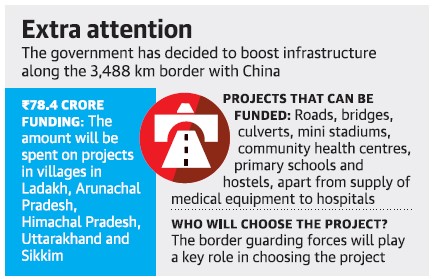
Details
- The Border Area Development Programme (BADP) has been allocated ₹784 crore in the 2020-21 fiscal and the money is distributed to the border States and Union Territories (UTs) depending on various criteria such as the length of the international border and population.
- Construction of roads, bridges, culverts, primary schools, health infrastructure, playfields, irrigation works, mini-stadiums, indoor courts for basketball, badminton and table tennis can be undertaken within 10 km of the border from the BADP funds.
- Forces such as the Border Security Force (BSF), deployed along the Bangladesh and Pakistan borders; the Indo-Tibetan Border Police (ITBP) on the China border; the Sashastra Seema Bal along the Nepal border; and the Assam Rifles stationed along the Myanmar border would provide independent feedback on the projects in the blocks concerned and may be tasked to conduct social audit of the works.
-Source: The Hindu




